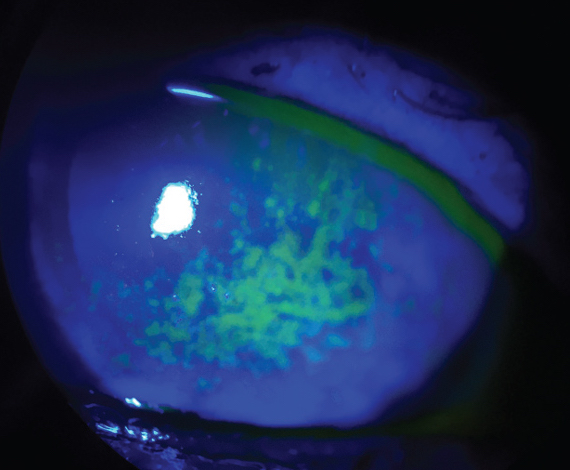 |
| Sjögren’s patients with severe dry eye may benefit from treatment with cyclosporine A. Photo: Vin Dang, OD. Click image to enlarge. |
A recent study in India provided further evidence that topical steroid therapy in conjunction with cyclosporine can help to alleviate clinical symptoms of dry eye disease (DED). The authors of the study reported that treatment with topical hydrocortisone combined with topical cyclosporine A resulted in fast improvement of severe DED in Sjögren’s patients. This approach is commonly used to treat dry eye, though in the United States, clinicians would most likely use loteprednol instead of topical hydrocortisone initially while treating with a cyclosporine-containing medication such as Restasis (Allergan) or Cequa (Sun Pharma).
The study included 24 eyes of 12 patients with severe DED associated with Sjögren’s syndrome. Patients received once-daily treatment with preservative-free cyclosporine A drops in both eyes for six months. Additionally, for the first two weeks of treatment, one eye of each patient received hydrocortisone drops three times daily.
The researchers reported that combination treatment with cyclosporine A and hydrocortisone resulted in significant differences from baseline in tear break-up time and corneal fluorescein staining. They noted a nonsignificant increase in TBUT and staining with cyclosporine A alone. After six months, both treatment groups exhibited significant increases from baseline in TBUT and corneal staining. The researchers pointed out that optical image quality on aberrometry measurements increased after six months in the combined cyclosporine A and hydrocortisone treatment group, while no significant changes were noted in eyes treated with cyclosporin A alone. They found no significant differences between the two treatment groups on aberrometry.
“Inflammatory mechanisms are important factors in the pathophysiology of DED, especially when associated with Sjögren’s syndrome, which is why the anti-inflammatory effects of cyclosporin A can be of use,” the researchers wrote in their paper. “Also, topical corticosteroids have potent and fast-acting anti-inflammatory effects with the potential for breaking the vicious circle between the immune response and damage to the ocular surface in DED. The fast relief of symptoms and clinical improvement make corticosteroids an attractive therapeutic choice for the treatment of severe DED.”
Importantly, they noted that unlike corticosteroids, cyclosporine A needs a longer period of time before its full effect manifests. “Corticosteroids should not be administered long-term because of possible side effects, such as the elevation of intraocular pressure, cataract development and opportunistic infections,” they pointed out in their paper. They noted that topical corticosteroids are often used as a pre-treatment medication or during the first few weeks. “In contrast to other corticosteroids, hydrocortisone has shown low ocular penetration, resulting in a lower risk of side effects. It is available in a preservative-free formulation.”
The authors concluded that combined topical hydrocortisone and topical cyclosporine A was an effective DED treatment in Sjögren’s patients. They added that other studies have found DED treatment success using methylprednisolone and loteprednol with cyclosporine A.
Fondi K, Miháltz K, Vécsei-Marlovits PV. Efficacy of topical hydrocortisone in combination with topical ciclosporin A for the treatment of dry eye disease in patients with Sjögren syndrome. J Ophthalmol. November 30, 2021. [Epub ahead of print]. |

